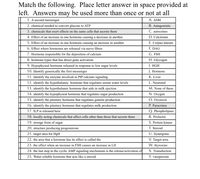
Human Anatomy & Physiology (11th Edition)
11th Edition
ISBN: 9780134580999
Author: Elaine N. Marieb, Katja N. Hoehn
Publisher: PEARSON
expand_more
expand_more
format_list_bulleted
Concept explainers
Question
All of them

Transcribed Image Text:Match the following. Place letter answer in space provided at
left. Answers may be used more than once or not at all
1. A second messenger
A. ADH
2. chemical needed to convert glucose to ATP
B. Antagonistic
3. chemicals that exert effects on the same cells that secrete them
C. autocrines
4. Effect of an increase in one hormone causing a decrease in another
D. Calcitonin
5. Effect of an increase in one hormone causing an increase in another
E. Corpus luteum
6. Effect where hormones are released via nerve fibers
F. DAG
7. Hormone responsible for the deposition of calcium
G. FSH
8. hormone types that has direct gene activation
H. Glycogen
9. Hypophyseal hormone released in response to low sugar levels
I. HGH
10. Identify generically the first messenger
J. Hormone
11. Identify the enzyme involved in PIP calcium signaling
K. Liver
12. identify the hypothalamic hormone that regulates serum water levels
L. Neuronal
13. identify the hypothalamic hormone that aids in milk ejection
M. None of these
14. identify the hypophyseal hormone that regulates sugar production
N. Oxygen
15. identify the pituitary hormone that regulates gamete production
O. Oxytocin
16. identify the pituitary hormone that regulates milk production
P. Paracrines
17. ILP is released here
Q. Phospholipase
18. locally acting chemicals that affect cells other than those that secrete them
R. Prolactin
19. storage form of sugar
S. Protein kinase
20. structure producing progesterone
T. Steroid
21. target area for HgH
U. Synergistic
22. the area that a hormone has its effect is called the
V. Target area
23. the effect when an increase in FSH causes an increase in LH
W. thyroxine
24. the last step in the cyclic AMP signaling mechanism is the release/activation of
X. Transduction
25. Water soluble hormone that acts like a steroid
Y. vasopressin
Expert Solution
arrow_forward
Step 1
Cells are the basic, functional event of the body. Cells communicate with each other and with their surroundings using chemical signals. These chemical signals are followed up and induced by chemical messengers in the body. These chemical messengers are known as hormones and they are the primary signaling molecules inside the body.
According to the guidelines, multiple questions cannot be answered. Please repost the questions separately.
Trending nowThis is a popular solution!
Step by stepSolved in 2 steps

Knowledge Booster
Learn more about
Need a deep-dive on the concept behind this application? Look no further. Learn more about this topic, biology and related others by exploring similar questions and additional content below.Similar questions
arrow_back_ios
SEE MORE QUESTIONS
arrow_forward_ios
Recommended textbooks for you
 Human Anatomy & Physiology (11th Edition)BiologyISBN:9780134580999Author:Elaine N. Marieb, Katja N. HoehnPublisher:PEARSON
Human Anatomy & Physiology (11th Edition)BiologyISBN:9780134580999Author:Elaine N. Marieb, Katja N. HoehnPublisher:PEARSON Biology 2eBiologyISBN:9781947172517Author:Matthew Douglas, Jung Choi, Mary Ann ClarkPublisher:OpenStax
Biology 2eBiologyISBN:9781947172517Author:Matthew Douglas, Jung Choi, Mary Ann ClarkPublisher:OpenStax Anatomy & PhysiologyBiologyISBN:9781259398629Author:McKinley, Michael P., O'loughlin, Valerie Dean, Bidle, Theresa StouterPublisher:Mcgraw Hill Education,
Anatomy & PhysiologyBiologyISBN:9781259398629Author:McKinley, Michael P., O'loughlin, Valerie Dean, Bidle, Theresa StouterPublisher:Mcgraw Hill Education, Molecular Biology of the Cell (Sixth Edition)BiologyISBN:9780815344322Author:Bruce Alberts, Alexander D. Johnson, Julian Lewis, David Morgan, Martin Raff, Keith Roberts, Peter WalterPublisher:W. W. Norton & Company
Molecular Biology of the Cell (Sixth Edition)BiologyISBN:9780815344322Author:Bruce Alberts, Alexander D. Johnson, Julian Lewis, David Morgan, Martin Raff, Keith Roberts, Peter WalterPublisher:W. W. Norton & Company Laboratory Manual For Human Anatomy & PhysiologyBiologyISBN:9781260159363Author:Martin, Terry R., Prentice-craver, CynthiaPublisher:McGraw-Hill Publishing Co.
Laboratory Manual For Human Anatomy & PhysiologyBiologyISBN:9781260159363Author:Martin, Terry R., Prentice-craver, CynthiaPublisher:McGraw-Hill Publishing Co. Inquiry Into Life (16th Edition)BiologyISBN:9781260231700Author:Sylvia S. Mader, Michael WindelspechtPublisher:McGraw Hill Education
Inquiry Into Life (16th Edition)BiologyISBN:9781260231700Author:Sylvia S. Mader, Michael WindelspechtPublisher:McGraw Hill Education

Human Anatomy & Physiology (11th Edition)
Biology
ISBN:9780134580999
Author:Elaine N. Marieb, Katja N. Hoehn
Publisher:PEARSON

Biology 2e
Biology
ISBN:9781947172517
Author:Matthew Douglas, Jung Choi, Mary Ann Clark
Publisher:OpenStax

Anatomy & Physiology
Biology
ISBN:9781259398629
Author:McKinley, Michael P., O'loughlin, Valerie Dean, Bidle, Theresa Stouter
Publisher:Mcgraw Hill Education,

Molecular Biology of the Cell (Sixth Edition)
Biology
ISBN:9780815344322
Author:Bruce Alberts, Alexander D. Johnson, Julian Lewis, David Morgan, Martin Raff, Keith Roberts, Peter Walter
Publisher:W. W. Norton & Company

Laboratory Manual For Human Anatomy & Physiology
Biology
ISBN:9781260159363
Author:Martin, Terry R., Prentice-craver, Cynthia
Publisher:McGraw-Hill Publishing Co.

Inquiry Into Life (16th Edition)
Biology
ISBN:9781260231700
Author:Sylvia S. Mader, Michael Windelspecht
Publisher:McGraw Hill Education